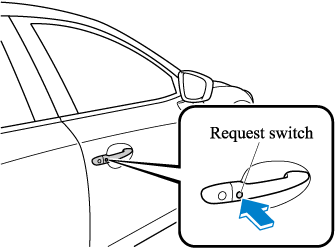

Locking, Unlocking with Request Switch (With the advanced keyless function)
All doors and the liftgate/boot lid can be locked/unlocked by pressing the request switch while the key is being carried.

To lock
To lock the doors and the liftgate/boot lid, press the request switch and the hazard warning lights will flash once.
A beep sound will be heard once.
To unlock
To unlock the doors and the liftgate/boot lid, press the request switch and the hazard warning lights will flash twice.
A beep sound will be heard twice.
-
Confirm that all doors and the liftgate/boot lid are securely locked.
For the liftgate/boot lid, move it without pressing the electric liftgate/boot lid opener to verify that the liftgate/boot lid has not been left ajar.
-
All doors and the liftgate/boot lid cannot be locked when any door or the liftgate is open.
-
It may require a few seconds for the doors to unlock after the request switch is pressed.
-
A beep sound is heard for confirmation when the doors and the liftgate/boot lid are locked/unlocked using the request switch. If you prefer, the beep sound can be turned off.
The volume of the beep sound can also be changed. Refer to Personalisation Features (Search).
Use the following procedure to change the setting.
-
Switch the ignition off and close all of the doors and the liftgate/boot lid.
-
Open the driver's door.
-
Within 30 seconds of opening the driver's door, press and hold the LOCK button on the key for 5 seconds or longer.
The beep sound activates at the currently set volume. The setting changes each time the LOCK button on the key is pressed and the beep sound activates at the set volume. (If the beep sound has been set to not activate, it will not activate.)
-
The setting change is completed by doing any one of the following:
-
Switching the ignition to ACC or ON.
-
Closing the driver's door.
-
Opening the liftgate/boot lid.
-
Not operating the key for ten seconds.
-
Pressing any button except the LOCK button on the key.
-
Pressing a request switch.
-
-
-
The setting can be changed so that the doors and the liftgate/boot lid are locked automatically without pressing the request switch.
Refer to Personalisation Features (Search).
(Walk-away auto lock function)
A beep sound is heard when all doors and the liftgate are closed while the advanced key is being carried. All doors and the liftgate/boot lid are locked automatically after about three seconds when the advanced key is out of the operational range. Also, the hazard warning lights flash once. (Even if the driver is in the operational range, all doors and the liftgate/boot lid are locked automatically after about 30 seconds.) If you are out of the operational range before the doors and the liftgate/boot lid are completely closed or another key is left in the vehicle, the walk-away auto lock function will not work. Always make sure that all doors and the liftgate/boot lid are closed and locked before leaving the vehicle. The walk-away auto lock function does not close the power windows.
-
(Auto re-lock function)
After unlocking with the request switch, all doors and the liftgate/boot lid will automatically lock if any of the following operations are not performed within about 30 seconds.
The time required for the doors to lock automatically can be changed.
Refer to Personalisation Features (Search).
-
Opening a door or the liftgate/boot lid.
-
Switching the ignition to any position other than off.
-




